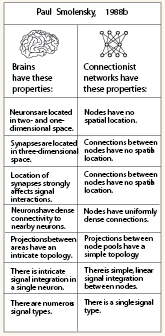Classical symbol manipulations are rough approximations of symbolic activity. Subsymbolic activity is, in turn, an abstraction from neural activity.
Explanations of all three kinds of activity—symbolic, subsymbolic, and neural—are legitimate for cognitive theory; so long as the proper importance of each is understood.
Paul Smolensky, 1988b.
Postulates of the Subsymbolic Paradigm1).
Subsymbols are fine-grained constituency symbols.
2) The relation between symbolic models (studied by classical AI) and symbolic models (studied by connectionism) is similar to the relation between classical Newtonian physics and quantum physics. Symbolic models are rough macro-level approximations of symbolic activity.
3) Subsymbolic processes are abstract implications of neural processes in the brain (see Sidebar, "
Connectionism and the brain", on this map). At present, it's an open question exactly how subsymbolic models relate to neural models.
4) Conscious application of rules takes place in a
conscious rule-interpreter. The conscious rule-interpreter interprets rules sequentially, and is relatively slow. It is well-suited to novel information, as well as to consciously formulated rules and knowledge. As such it is best analysed at the conceptual level as a symbolic process.
5) The conscious rule-interpreter is a virtual machine that is a run on an
inituitive processor.
6) The intuitive processor is responsible for most behaviour, including linguistic behaviour, problem-solving, and all skilled performance. The intuitive processor handles unconscious, learned activities, operates in parallel, and is relatively fast. The intuitive processor is best analysed at the subconceptual level as a symbolic process.
Notes:
Smolensky also calls this argument the "proper treatment of connectionism" or "PTC".
Smolensky distinguishes levels of analysis (conceptual, subconceptual, and neural) and cognitive systems (symbolic, subsymbolic, and neural). It may be important to remember that his distinction is often ignored in other authors discussions' of levels.
Conceptual level: Preferred level of description of symbolic processes. At this level, concepts and rules are consciously formulated and understood. This level is similar to Newtonian physics in that it offers an approximation of lower-level microtheory.
Subconceptual level: Preferred level of description of subsymbolic processes in the connectionist dynamical system, and the fundamental level for the study of the mind. Fine-grained features of symbols and simple processing is studied in this level.
Neural level: Preferred level of description of processing in the brain. The neural level describes many biological details that are not relevant to the subconceptual level, which makes appropriate computation abstractions.
Connectionism and the BrainConnectionist networks are usually described as being "neurally plausible" or "neurally inspired". They do not exactly simulate the operation of the brain, but they do capture some of its basic computational principles. For example:
- Both brains and connectionist networks process information by using numerous interconnected processing units (neurons in the brain; nodes in a connectionist network).
- Both brains and connectionist networks learn by modifying connections between processing units (synapses in the brain; weights in a connectionist network).
- Both brains and connectionist networks exhibit distributed, "self organising" behaviour.
Despite such similarities, connectionist networks make various abstractions (or "simplifying assumptions") from real neural processes in the brain. For example:
- Connectionist networks use fewer units and connections than are found in real neural networks. It is usually assumed, for example, that a given node corresponds to a large collection of real neurons.
- Connectionist networks use weights that can switch between inhibitory and excitatory. Synapses in the brain are either inhibitory or excitatory, but never both.
- Many connectionist learning schemes, especially backpropagation, and clearly nonbiological. Nothing in the brain resembles the process of backwards propagation of error that is used in most modern connectionist networks.
To what extent connectionist networks will ultimately come to resemble the brain is an open question and a topic of ongoing research.

 Notes
Notes:
Connectionist researchers have a spectrum of concerns. Whereas computational neuroscientists are directly concerned with modelling the brain, neural engineers apply connectionist principles without concerns for neural realism.
A similar distinction is made in the field of artificial intelligence, between simulated thinking and "whatever works".